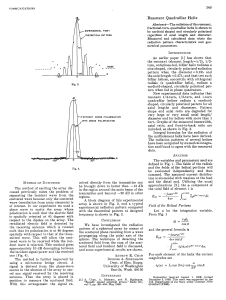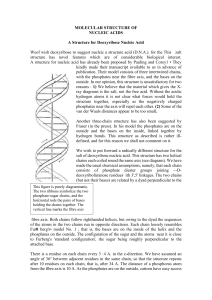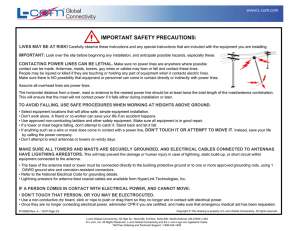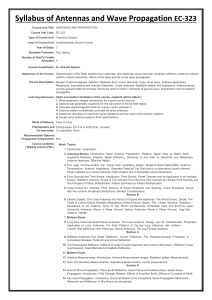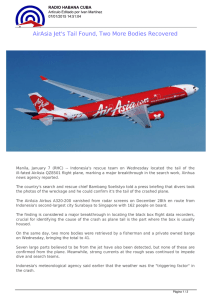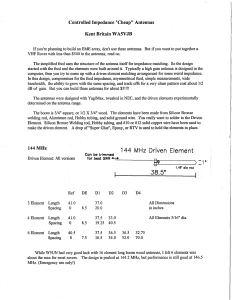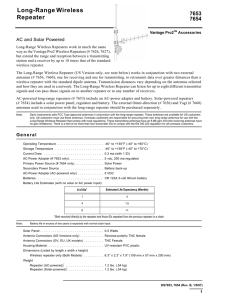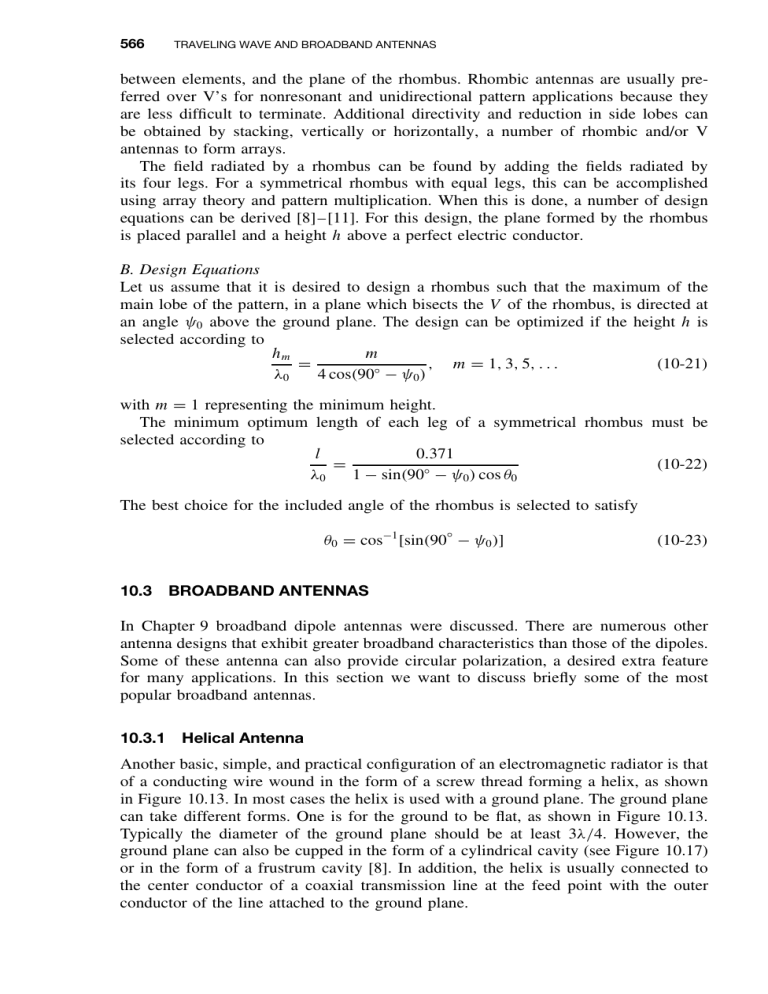
566 TRAVELING WAVE AND BROADBAND ANTENNAS between elements, and the plane of the rhombus. Rhombic antennas are usually preferred over V’s for nonresonant and unidirectional pattern applications because they are less difficult to terminate. Additional directivity and reduction in side lobes can be obtained by stacking, vertically or horizontally, a number of rhombic and/or V antennas to form arrays. The field radiated by a rhombus can be found by adding the fields radiated by its four legs. For a symmetrical rhombus with equal legs, this can be accomplished using array theory and pattern multiplication. When this is done, a number of design equations can be derived [8]–[11]. For this design, the plane formed by the rhombus is placed parallel and a height h above a perfect electric conductor. B. Design Equations Let us assume that it is desired to design a rhombus such that the maximum of the main lobe of the pattern, in a plane which bisects the V of the rhombus, is directed at an angle ψ0 above the ground plane. The design can be optimized if the height h is selected according to hm m , m = 1, 3, 5, . . . (10-21) = λ0 4 cos(90◦ − ψ0 ) with m = 1 representing the minimum height. The minimum optimum length of each leg of a symmetrical rhombus must be selected according to l 0.371 = (10-22) λ0 1 − sin(90◦ − ψ0 ) cos θ0 The best choice for the included angle of the rhombus is selected to satisfy ◦ θ0 = cos−1 [sin(90 − ψ0 )] 10.3 (10-23) BROADBAND ANTENNAS In Chapter 9 broadband dipole antennas were discussed. There are numerous other antenna designs that exhibit greater broadband characteristics than those of the dipoles. Some of these antenna can also provide circular polarization, a desired extra feature for many applications. In this section we want to discuss briefly some of the most popular broadband antennas. 10.3.1 Helical Antenna Another basic, simple, and practical configuration of an electromagnetic radiator is that of a conducting wire wound in the form of a screw thread forming a helix, as shown in Figure 10.13. In most cases the helix is used with a ground plane. The ground plane can take different forms. One is for the ground to be flat, as shown in Figure 10.13. Typically the diameter of the ground plane should be at least 3λ/4. However, the ground plane can also be cupped in the form of a cylindrical cavity (see Figure 10.17) or in the form of a frustrum cavity [8]. In addition, the helix is usually connected to the center conductor of a coaxial transmission line at the feed point with the outer conductor of the line attached to the ground plane. BROADBAND ANTENNAS Figure 10.13 567 Helical antenna with ground plane. The geometrical configuration of a helix consists usually of N turns, diameter D and spacing S between each turn. The total length of the antenna is√L = N S while √ the total length of the wire is Ln = N L0 = N S 2 + C 2 where L0 = S 2 + C 2 is the length of the wire between each turn and C = πD is the circumference of the helix. Another important parameter is the pitch angle α which is the angle formed by a line tangent to the helix wire and a plane perpendicular to the helix axis. The pitch angle is defined by α = tan−1 S πD = tan−1 S C (10-24) When α = 0◦ , then the winding is flattened and the helix reduces to a loop antenna of N turns. On the other hand, when α = 90◦ then the helix reduces to a linear wire. When 0◦ < α < 90◦ , then a true helix is formed with a circumference greater than zero but less than the circumference when the helix is reduced to a loop (α = 0◦ ). The radiation characteristics of the antenna can be varied by controlling the size of its geometrical properties compared to the wavelength. The input impedance is critically dependent upon the pitch angle and the size of the conducting wire, especially near the feed point, and it can be adjusted by controlling their values. The general polarization of the antenna is elliptical. However circular and linear polarizations can be achieved over different frequency ranges. 568 TRAVELING WAVE AND BROADBAND ANTENNAS z z y x (a) normal mode x y (b) end-fire mode Figure 10.14 Three-dimensional normalized amplitude linear power patterns for normal and end-fire modes helical designs. The helical antenna can operate in many modes; however the two principal ones are the normal (broadside) and the axial (end-fire) modes. The three-dimensional amplitude patterns representative of a helix operating, respectively, in the normal (broadside) and axial (end-fire) modes are shown in Figure 10.14. The one representing the normal mode, Figure 10.14(a), has its maximum in a plane normal to the axis and is nearly null along the axis. The pattern is similar in shape to that of a small dipole or circular loop. The pattern representative of the axial mode, Figure 10.14(b), has its maximum along the axis of the helix, and it is similar to that of an end-fire array. More details are in the sections that follow. The axial (end-fire) mode is usually the most practical because it can achieve circular polarization over a wider bandwidth (usually 2:1) and it is more efficient. Because an elliptically polarized antenna can be represented as the sum of two orthogonal linear components in time-phase quadrature, a helix can always receive a signal transmitted from a rotating linearly polarized antenna. Therefore helices are usually positioned on the ground for space telemetry applications of satellites, space probes, and ballistic missiles to transmit or receive signals that have undergone Faraday rotation by traveling through the ionosphere. A. Normal Mode In the normal mode of operation the field radiated by the antenna is maximum in a plane normal to the helix axis and minimum along its axis, as shown sketched in Figure 10.14(a), which is a figure-eight rotated about its axis similar to that of a linear dipole of l < λ0 or a small loop (a λ0 ). To achieve the normal mode of operation, the dimensions of the helix are usually small compared to the wavelength (i.e., N L0 λ0 ). The geometry of the helix reduces to a loop of diameter D when the pitch angle approaches zero and to a linear wire of length S when it approaches 90◦ . Since the limiting geometries of the helix are a loop and a dipole, the far field radiated by a small helix in the normal mode can be described in terms of Eθ and Eφ components of the dipole and loop, respectively. In the normal mode, the helix of Figure 10.15(a) can 569 BROADBAND ANTENNAS Figure 10.15 Normal (broadside) mode for helical antenna and its equivalent. be simulated approximately by N small loops and N short dipoles connected together in series as shown in Figure 10.14(b). The fields are obtained by superposition of the fields from these elemental radiators. The planes of the loops are parallel to each other and perpendicular to the axes of the vertical dipoles. The axes of the loops and dipoles coincide with the axis of the helix. Since in the normal mode the helix dimensions are small, the current throughout its length can be assumed to be constant and its relative far-field pattern to be independent of the number of loops and short dipoles. Thus its operation can be described accurately by the sum of the fields radiated by a small loop of radius D and a short dipole of length S, with its axis perpendicular to the plane of the loop, and each with the same constant current distribution. The far-zone electric field radiated by a short dipole of length S and constant current I0 is Eθ , and it is given by (4-26a) as Eθ = j η kI0 Se−jkr sin θ 4πr (10-25) where l is being replaced by S. In addition the electric field radiated by a loop is Eφ , and it is given by (5-27b) as Eφ = η k 2 (D/2)2 I0 e−j kr sin θ 4r (10-26) where D/2 is substituted for a. A comparison of (10-25) and (10-26) indicates that the two components are in time-phase quadrature, a necessary but not sufficient condition for circular or elliptical polarization. 570 TRAVELING WAVE AND BROADBAND ANTENNAS The ratio of the magnitudes of the Eθ and Eφ components is defined here as the axial ratio (AR), and it is given by AR = 4S |Eθ | 2λS = = |Eφ | πkD 2 (πD)2 (10-27) By varying the D and/or S the axial ratio attains values of 0 ≤ AR ≤ ∞. The value of AR = 0 is a special case and occurs when Eθ = 0 leading to a linearly polarized wave of horizontal polarization (the helix is a loop). When AR = ∞, Eφ = 0 and the radiated wave is linearly polarized with vertical polarization (the helix is a vertical dipole). Another special case is the one when AR is unity (AR = 1) and occurs when 2λ0 S =1 (πD)2 (10-28) or C = πD = √ 2Sλ0 (10-28a) for which tan α = πD S = πD 2λ0 (10-29) When the dimensional parameters of the helix satisfy the above relation, the radiated field is circularly polarized in all directions other than θ = 0◦ where the fields vanish. When the dimensions of the helix do not satisfy any of the above special cases, the field radiated by the antenna is not circularly polarized. The progression of polarization change can be described geometrically by beginning with the pitch angle of zero degrees (α = 0◦ ), which reduces the helix to a loop with linear horizontal polarization. As α increases, the polarization becomes elliptical √ with the major axis being horizontally polarized. When α, is such that C/λ0 = 2S/λ0 , AR = 1 and we have circular polarization. For greater values of α, the polarization again becomes elliptical but with the major axis vertically polarized. Finally when α = 90◦ the helix reduces to a linearly polarized vertical dipole. To achieve the normal mode of operation, it has been assumed that the current throughout the length of the helix is of constant magnitude and phase. This is satisfied to a large extent provided the total length of the helix wire NL0 is very small compared to the wavelength (Ln λ0 ) and its end is terminated properly to reduce multiple reflections. Because of the critical dependence of its radiation characteristics on its geometrical dimensions, which must be very small compared to the wavelength, this mode of operation is very narrow in bandwidth and its radiation efficiency is very small. Practically this mode of operation is limited, and it is seldom utilized. B. Axial Mode A more practical mode of operation, which can be generated with great ease, is the axial or end-fire mode. In this mode of operation, there is only one major lobe and its BROADBAND ANTENNAS 571 maximum radiation intensity is along the axis of the helix, as shown in Figure 10.14(b). The minor lobes are at oblique angles to the axis. To excite this mode, the diameter D and spacing S must be large fractions of the wavelength. To achieve circular polarization, primarily in the major lobe, the circumference of the helix must be in the 34 < C/λ0 < 43 range (with C/λ0 = 1 near optimum), and the spacing about S λ0 /4. The pitch angle is usually 12◦ ≤ α ≤ 14◦ . Most often the antenna is used in conjunction with a ground plane, whose diameter is at least λ0 /2, and it is fed by a coaxial line. However, other types of feeds (such as waveguides and dielectric rods) are possible, especially at microwave frequencies. The dimensions of the helix for this mode of operation are not as critical, thus resulting in a greater bandwidth. C. Design Procedure The terminal impedance of a helix radiating in the axial mode is nearly resistive with values between 100 and 200 ohms. Smaller values, even near 50 ohms, can be obtained by properly designing the feed. Empirical expressions, based on a large number of measurements, have been derived [8], and they are used to determine a number of parameters. The input impedance (purely resistive) is obtained by R 140 C λ0 (10-30) which is accurate to about ±20%, the half-power beamwidth by 3/2 HPBW (degrees) 52λ0 √ C NS (10-31) the beamwidth between nulls by 3/2 FNBW (degrees) 115λ0 √ C NS (10-32) the directivity by D0 (dimensionless) 15N C2S λ30 (10-33) the axial ratio (for the condition of increased directivity) by AR = 2N + 1 2N (10-34) 572 TRAVELING WAVE AND BROADBAND ANTENNAS and the normalized far-field pattern by E = sin π sin[(N/2)ψ] cos θ 2N sin[ψ/2] (10-35) where ψ = k0 S cos θ − p= L0 /λ0 S/λ0 + 1 p= L0 /λ0 2N + 1 S/λ0 + 2N L0 p (10-35a) For ordinary end-fire radiation (10-35b) For Hansen-Woodyard end-fire radiation (10-35c) All these relations are approximately valid provided 12◦ < α < 14◦ , 34 < C/λ0 < 43 , and N > 3. The far-field pattern of the helix, as given by (10-35), has been developed by assuming that the helix consists of an array of N identical turns (each of nonuniform current and identical to that of the others), a uniform spacing S between them, and the elements are placed along the z-axis. The cos θ term in (10-35) represents the field pattern of a single turn, and the last term in (10-35) is the array factor of a uniform array of N elements. The total field is obtained by multiplying the field from one turn with the array factor (pattern multiplication). The value of p in (10-35a) is the ratio of the velocity with which the wave travels along the helix wire to that in free space, and it is selected according to (10-35b) for ordinary end-fire radiation or (10-35c) for Hansen-Woodyard end-fire radiation. These are derived as follows. For ordinary end-fire the relative phase ψ among the various turns of the helix (elements of the array) is given by (6-7a), or ψ = k0 S cos θ + β (10-36) where d = S is the spacing between the turns of the helix. For an end-fire design, the radiation from each one of the turns along θ = 0◦ must be in phase. Since the wave along the helix wire between turns travels a distance L0 with a wave velocity v = pv0 (p < 1 where v0 is the wave velocity in free space) and the desired maximum radiation is along θ = 0◦ , then (10-36) for ordinary end-fire radiation is equal to ψ = (k0 S cos θ − kL0 )θ=0◦ = k0 S − L0 p = −2πm, m = 0, 1, 2, . . . (10-37) Solving (10-37) for p leads to p= L0 /λ0 S/λ0 + m (10-38) BROADBAND ANTENNAS 573 For m = 0 and p = 1, L0 = S. This corresponds to a straight wire (α = 90◦ ), and not a helix. Therefore the next value is m = 1, and it corresponds to the first transmission mode for a helix. Substituting m = 1 in (10-38) leads to p= L0 /λ0 S/λ0 + 1 (10-38a) which is that of (10-35b). In a similar manner, it can be shown that for Hansen-Woodyard end-fire radiation (10-37) is equal to ψ = (k0 S cos θ − kL0 )θ=0◦ = k0 S − L0 p π , = − 2πm + N m = 0, 1, 2, . . . (10-39) which when solved for p leads to p= L0 /λ0 2mN + 1 S/λ0 + 2N (10-40) For m = 1, (10-40) reduces to p= L0 /λ0 2N + 1 S/λ0 + 2N (10-40a) which is identical to (10-35c). Example 10.1 Design a 10-turn helix to operate in the axial mode. For an optimum design, 1. Determine the: a. Circumference (in λo ), pitch angle (in degrees), and separation between turns (in λo ) b. Relative (to free space) wave velocity along the wire of the helix for: i. Ordinary end-fire design ii. Hansen-Woodyard end-fire design c. Half-power beamwidth of the main lobe (in degrees) d. Directivity (in dB) using: i. A formula ii. The computer program Directivity of Chapter 2 e. Axial ratio (dimensionless and in dB ) 2. Plot the normalized three-dimensional linear power pattern for the ordinary and Hansen-Woodyard designs. 574 TRAVELING WAVE AND BROADBAND ANTENNAS Solution: 1. a. For an optimum design C ◦ ◦ 13 ⇒ S = C tan α = λo tan(13 ) = 0.231λo λo , α b. The length of a single turn is Lo = S 2 + C 2 = λo (0.231)2 + (1)2 = 1.0263λo Therefore the relative wave velocity is: i. Ordinary end-fire: p= 1.0263 Lo /λo νh = = 0.8337 = νo So /λo + 1 0.231 + 1 ii. Hansen-Woodyard end-fire: νh = νo Lo /λo 1.0263 = 0.8012 = 2N + 1 0.231 + 21/20 So /λo + 2N c. The half-power beamwidth according to (10-31) is p= 3/2 HPBW 52λo 52 ◦ = 34.2135 = √ √ 1 10(0.231) C NS d. The directivity is: i. Using (10-33): Do 15N C2S = 15(10)(1)2 (0.231) = 34.65 (dimensionless) λ3o = 15.397 dB ii. Using the computer program Directivity and (10-35): a. ordinary end-fire (p = 0.8337): Do = 12.678 (dimensionless) = 11.03 dB b. H-W end-fire (p = 0.8012): Do = 26.36 (dimensionless) = 14.21 dB e. The axial ratio according to (10-34) is: AR = 20 + 1 2N + 1 = = 1.05 (dimensionless) = 0.21 dB 2N 20 2. The three-dimensional linear power patterns for the two end-fire designs, ordinary and Hansen-Woodyard, are shown in Figure 10.16. BROADBAND ANTENNAS 575 (b) Hansen-Woodyard end-fire (a) ordinary end-fire Figure 10.16 Three-dimensional normalized amplitude linear power patterns for helical ordinary (p = 0.8337) and Hansen-Woodyard (p = 0.8012) end-fire designs. D. Feed Design The nominal impedance of a helical antenna operating in the axial mode, computed using (10-30), is 100–200 ohms. However, many practical transmission lines (such as a coax) have characteristic impedance of about 50 ohms. In order to provide a better match, the input impedance of the helix must be reduced to near that value. There may be a number of ways by which this can be accomplished. One way to effectively control the input impedance of the helix is to properly design the first 1/4 turn of the helix which is next to the feed [8], [12]. To bring the input impedance of the helix from nearly 150 ohms down to 50 ohms, the wire of the first 1/4 turn should be flat in the form of a strip and the transition into a helix should be very gradual. This is accomplished by making the wire from the feed, at the beginning of the formation of the helix, in the form of a strip of width w by flattening it and nearly touching the ground plane which is covered with a dielectric slab of height [2] h= w 377 −2 √ Ir Z0 (10-41) where w = width of strip conductor of the helix starting at the feed Ir = dielectric constant of the dielectric slab covering the ground plane Z0 = characteristic impedance of the input transmission line Typically the strip configuration of the helix transitions from the strip to the regular circular wire and the designed pitch angle of the helix very gradually within the first 1/4–1/2 turn. This modification decreases the characteristic impedance of the conductor-ground plane effective transmission line, and it provides a lower impedance over a substantial 576 TRAVELING WAVE AND BROADBAND ANTENNAS but reduced bandwidth. For example, a 50-ohm helix has a VSWR of less than 2:1 over a 40% bandwidth compared to a 70% bandwidth for a 140-ohm helix. In addition, the 50-ohm helix has a VSWR of less than 1.2:1 over a 12% bandwidth as contrasted to a 20% bandwidth for one of 140 ohms. A simple and effective way of increasing the thickness of the conductor near the feed point will be to bond a thin metal strip to the helix conductor [12]. For example, a metal strip 70-mm wide was used to provide a 50-ohm impedance in a helix whose conducting wire was 13-mm in diameter and it was operating at 230.77 MHz. A commercially available helix with a cupped ground plane is shown in Figure 10.17. It is right-hand circularly-polarized (RHCP) operating between 100–160 MHz with a gain of about 6 dB at 100 MHz and 12.8 dB at 160 MHz. The right-hand winding of the wire is clearly shown in the photo. The axial ratio is about 8 dB at 100 MHz and 2 dB at 160 MHz. The maximum VSWR in the stated operating frequency, relative to a 50-ohm line, does not exceed 3:1. A MATLAB computer program, entitled Helix, has been developed to analyze and design a helical antenna. The description of the program is found in the corresponding READ ME file included in the CD attached to the book. 10.3.2 Electric-Magnetic Dipole It has been shown in the previous section that the circular polarization of a helical antenna operating in the normal mode was achieved by assuming that the geometry of the helix is represented by a number of horizontal small loops and vertical infinitesimal dipoles. It would then seem reasonable that an antenna with only one loop and a single vertical dipole would, in theory, represent a radiator with an elliptical polarization. Ideally circular polarization, in all space, can be achieved if the current in each element can be controlled, by dividing the available power between the dipole and the loop, so that the magnitude of the field intensity radiated by each is equal. Figure 10.17 Commercial helix with a cupped ground plane. (Courtesy: Seavey Engineering Associates, Inc, Pembroke, MA).
